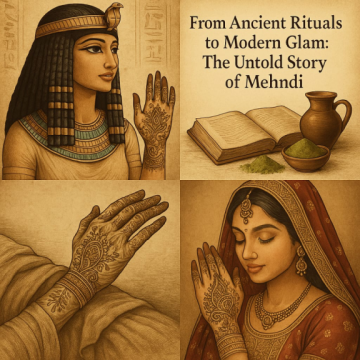From Ancient Rituals to Modern Glam: The Untold Story of Mehndi
This blog uncovers the rich and lesser-known history of mehndi (henna), tracing its origins from ancient Egyptian rituals to its role in modern beauty culture. Once used by queens and warriors for protection, power, and healing, mehndi has evolved across civilizations while preserving its spiritual and artistic essence. Today, it's more than decoration – it's a living tradition that connects us to thousands of years of heritage and storytelling.
Mehndi, also known as henna, is more than just decorative art – it's a symbol of celebration, protection, and feminine beauty that dates back over 5,000 years. Though often linked with Indian weddings, the roots of mehndi trace back to ancient Egypt, where queens like Cleopatra used henna to dye their nails and hair as a sign of wealth and divine connection.
What many don’t know is that the earliest evidence of henna use was found in the mummified hands of Egyptian pharaohs – applied not just for aesthetics, but as a spiritual shield in the afterlife.
From Egypt, henna spread to Persia, North Africa, and the Indian subcontinent, evolving with every culture it touched. In ancient India, mehndi was more than bridal beauty – it was believed to carry cooling properties, helping women stay calm and refreshed in the desert heat.
One of the lesser-known facts is that mehndi paste was once used by warriors before battle – not for decoration, but to boost mental strength and ward off evil.
In modern times, mehndi has crossed oceans and borders, inspiring global fashion trends, temporary tattoos, and even western brides. Yet its soul remains rooted in ritual, healing, and storytelling.
Ending Line:
Today, when we draw those delicate swirls and florals on our hands, we're not just creating art – we're continuing a powerful tradition that once danced through the sands of ancient deserts and royal palaces.
https://youtube.com/shorts/rY2vMbxk_nE?si=_5EqY3mz1dy4Ng5J






Sarah Williams
February 13, 2025Proin iaculis purus consequat sem cure digni ssim donec porttitora entum suscipit rhoncus. Accusantium quam, ultricies eget id, aliquam eget nibh et. Maecen aliquam, risus at semper.
James Cooper
February 13, 2025Quisque ut nisi. Donec mi odio, faucibus at, scelerisque quis, convallis in, nisi. Suspendisse non nisl sit amet velit hendrerit rutrum. Ut leo. Ut a nisl id ante tempus hendrerit.
Rachel Adams
February 13, 2025Vivamus elementum semper nisi. Aenean vulputate eleifend tellus. Aenean leo ligula, porttitor eu, consequat vitae, eleifend ac, enim.